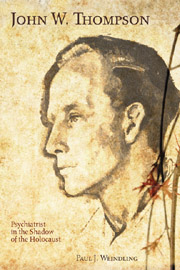Book contents
- Frontmatter
- Contents
- List of Illustrations
- Acknowledgments
- List of Abbreviations
- Part One Into the Dark
- Part Two Redemption
- 9 Belsen, “My Crucifix”
- 10 Medical War Crimes Revelations
- 11 Experimental Ethics
- 12 Therapist for the German Patient
- Part Three Aftermath
- Appendix John Thompson's Writings
- Notes
- Sources
- Index
10 - Medical War Crimes Revelations
from Part Two - Redemption
Published online by Cambridge University Press: 12 September 2012
- Frontmatter
- Contents
- List of Illustrations
- Acknowledgments
- List of Abbreviations
- Part One Into the Dark
- Part Two Redemption
- 9 Belsen, “My Crucifix”
- 10 Medical War Crimes Revelations
- 11 Experimental Ethics
- 12 Therapist for the German Patient
- Part Three Aftermath
- Appendix John Thompson's Writings
- Notes
- Sources
- Index
Summary
The FIAT Reports
Allied scientific intelligence searched for hidden stockpiles of deadly German atomic and chemical weapons and biological warfare agents. The Canadian Advisory Targets Committee aimed to secure military, scientific, and technical intelligence and offered Canadian technical specialists to the British. These specialists had to make sense of the sprawling German wartime scientific edifice with its branches in medical and weapons research.
S/L Thompson transferred to a military intelligence unit on September 2, 1945 as part of a contingent of Canadian scientists on loan to the British. He became chief of the scientific and technical branch of the British scientific intelligence agency FIAT (an acronym for Field Information Agency Technical). The British Element of FIAT ran parallel branches for the army, navy, and air force as well as for the economy, industry, and science and technology. The main FIAT office was at Hoechst, once IG Farben's center of chemical and pharmaceutical production. This posting brought Thompson into frontline engagement with Nazi scientists. He found a chaos of competing scientific groups mired in destructive Nazi Party, SS, and military structures.
Fiat—“let it be done”—had an appealing religious connotation of the Creator. Thompson used the phrase “fiat voluntas tua” as he pursued his several agendas. He made available the results of German wartime research, investigated unethical experiments on living human subjects, psychologically assessed defendants at Nuremberg, and screened German scientists for their suitability to work in Canada.
- Type
- Chapter
- Information
- John W. ThompsonPsychiatrist in the Shadow of the Holocaust, pp. 107 - 136Publisher: Boydell & BrewerPrint publication year: 2010



